From the Editor
Recollections: Life on the Land
Sled Dogs of Russia
An Examination of Traditional Knowledge:
The Case of the Inuit Sled Dog, Part 2
In the News
For the Love of a Retired Sled Dog
The Chinook Project to Visit Labrador
Behavior Notebook: Some Aspects of Dog Behavior
Behavior Notebook: More on Boss Dogs
About Previous Articles in The Fan Hitch
IMHO: Timelessness
Navigating This Site
Index of articles by subject
Index of back issues by volume number
Search The Fan Hitch
Articles to download and print
Ordering Ken MacRury's Thesis
Our comprehensive list of resources
Talk to The Fan Hitch
The Fan Hitch home page
ISDI home page
Editor-in-Chief: Sue Hamilton
Webmaster: Mark Hamilton
Print Edition: Imaged and distributed by the IPL students of the Ulluriaq School, Kangiqsualujjuaq, Nunavik
The
Fan Hitch,
Journal of the Inuit Sled Dog International,
is published four times a
year. It is available at no cost online at:
https://thefanhitch.org.
Print subscriptions: in Canada $20.00, in USA $23.00, elsewhere $32.00 per year, postage included. All prices are in Canadian dollars. Make checks payable in Canadian dollars only to "Mark Brazeau", and send to Mark Brazeau, Box 151 Kangiqsualujjuaq QC J0M 1N0 Canada. (Back issues are also available. Contact Sue Hamilton.)
The Fan Hitch welcomes your letters, stories, comments and suggestions. The editorial staff reserves the right to edit submissions used for publication.
Contents of The Fan Hitch are protected by international copyright laws. No photo, drawing or text may be reproduced in any form without written consent. Webmasters please note: written consent is necessary before linking this site to yours! Please forward requests to Sue Hamilton, 55 Town Line Rd., Harwinton, Connecticut 06791, USA or mail@thefanhitch.org
Print subscriptions: in Canada $20.00, in USA $23.00, elsewhere $32.00 per year, postage included. All prices are in Canadian dollars. Make checks payable in Canadian dollars only to "Mark Brazeau", and send to Mark Brazeau, Box 151 Kangiqsualujjuaq QC J0M 1N0 Canada. (Back issues are also available. Contact Sue Hamilton.)
The Fan Hitch welcomes your letters, stories, comments and suggestions. The editorial staff reserves the right to edit submissions used for publication.
Contents of The Fan Hitch are protected by international copyright laws. No photo, drawing or text may be reproduced in any form without written consent. Webmasters please note: written consent is necessary before linking this site to yours! Please forward requests to Sue Hamilton, 55 Town Line Rd., Harwinton, Connecticut 06791, USA or mail@thefanhitch.org
The Inuit Sled Dog International
The Inuit Sled Dog International (ISDI) is a consortium of enthusiasts whose goal is the preservation of this ancient arctic breed in its purest form as a working dog. The ISDI's efforts are concentrated on restoring the pure Inuit Dog to its native habitat. The ISDI's coordinators welcome to your comments and questions.
ISDI Coordinator Canada:
Geneviève Montcombroux, Box 206, Inwood, MB R0C 1P0; gmontcombroux@gmail.com
ISDI Coordinator USA:
Sue Hamilton, 55 Town Line Road, Harwinton, CT 06791, mail@thefanhitch.org
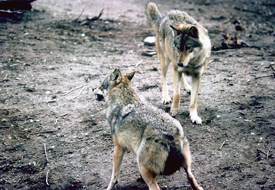
With a little fear of aggression, the wolf on
the left shows submissive behavior to the
dominant wolf (right). photo: ter Berg
Some Aspects of Dog Behavior
by Evert Jan ter Berg
The Netherlands
Stijn Heijs wrote in the June 2009 issue of The Fan Hitch an article about me and my Inuit Dogs. I was asked to contribute some more information, and I'd like to do that.
I will first explain why I choose for my studies Inuit Dogs and German Shepherds and later on pariah dogs. In the beginning of 1970 I started keeping dogs in small family groups of about three to six individuals. I got the opportunity to compare two types of dogs: Inuit Dogs and German Shepherds. I choose these two types because they were complete. They had all the attributes, like full tails and ears and a head with the possibility for a good expression to show the signals of specific behavior. But I also choose these two types because they are very different. The Inuit Dog is an old original type of dog and the German Shepherd a more recent modern breed. I was curious to see if there were differences and also similarities in their social behavior. After this period, which lasted over fifteen years, observing these two breed types, there followed another long period of studying dogs, only this time the pariah dogs of south east Asia. Pariah dogs and Dingo type dogs are also very old original dogs.
In 1995 I stopped with this project and then I started traveling through Africa, Asia, South East Asia and Central America to observe and make photos of local pariah dogs and dingo type dogs in several countries.
At my own home I also had the opportunity to study for one-and-a-half years the behavior of two wolves which I kept in my back yard. In my opinion wolves should not be kept as pets. I still believe so even after reading the amazing book The Philosopher and the Wolf written by Mark Rowlands. I got these wolves from two different people who tried unsuccessfully to keep them as pets. They lived in urban areas and got into trouble with their neighbors because of the wolves. They asked me if I could take care of the wolves, which I did, but with the understanding that it would be only until they found a place in rural area with enough space to keep this animals. This happened and the wolves left after one-and-a-half years.
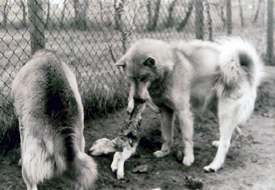
Dominant Inuit Dog male takes food away from
subordinate female. photo: ter Berg
There are several elements in social behavior of dogs, but the most important are: dominant behavior and subordinate behavior. Dominance and subordination are the most important elements within a social living group, as seen in wolf society. But still there are several systems. The dominant structure in a big group of wolves, of about 15-20 members, is not linear. The top dominant animals, the alpha male and the alpha female are dominant to the whole group. But below this top level there are many variants. The dominant structure within a group is not always a stable fact. In a smaller group, like Indian wolves which live more in couples with their young, the subordinate structure is much more simple, as it was with my dogs, which lived in small family groups of 4-6 individuals.
Changes in dominant and subordinate positions can occur. It happened with my dogs sometimes, in particular with the Inuit Dogs and the pariah dogs. When the alpha animals became older they could loose their dominant position and they had to accept a lower position. Before such changes there were regular fights between some of the dogs. But when there were enough escape possibilities, then after these conflicts the group stabilized again. The former alpha animal accepted his or her new position. These processes were far more complicated between females compared with male dogs. Dominant and subordinate behavior is showed by body posture and signals of tail, ears and head. When, as with several modern breeds, these parts disappeared by cutting tails or ears or extreme face deformation, to recognize dominant and subordinate behavior will be rather difficult for the dogs (and for humans) and it leads to unnecessary aggressive behavior.
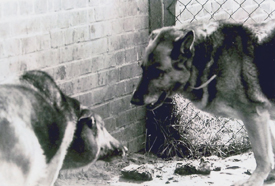
Full grown but young German Shepherd female shows
submission towards her mother. photo: ter Berg
I observed that the Inuit Dogs and pariah dogs were different from my German Shepherds. The alpha German Shepherds, both males and females, were more tolerant to subordinating dogs within the family groups as compared with the Inuit Dogs and the pariah dogs. Also German Shepherd males were less strict towards young dogs compared with Inuit Dogs and pariah dogs. Young dogs were outside this dominance structure until the age of around five to six months. They could, without any problem, get food without restriction from the dominant dog. After that age this changed. From that time it was the alpha male who was active with the decision if young dogs were allowed to eat or not to eat from the common food source. But it never came to aggression.
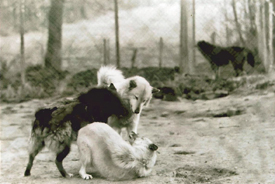
Situation with alpha male and alpha female Inuit Dogs
and a subordinate full grown youngster. photo: ter Berg
In general the social order between Inuit Dogs and pariah dogs was more strict than with the German Shepherds. Sometimes, only during rare moments, the dominant dog still attacked a subordinate dog showing complete submissive behavior. My observation makes it clear that these sudden attacks were a correction from the dominant dog because the attacked dog did not show enough submissive behavior in several situations before the attack. The sudden attacks by a dominant dog were violent and short, but without serious injuries. Afterwards, the attacked dog showed proper submissive behavior. And again these conflicts occurred much more with my Inuit and pariah dogs than with my German Shepherds.
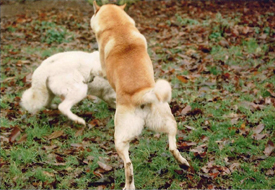
Sudden serious attack by a dominant pariah dog upon
a subordinate dog. photo: ter Berg
My conclusion is that the dominant and subordinate behavior patterns were more visible with Inuit Dogs and pariah dogs than with my German Shepherds. But after several years of living together without human interference even my German Shepherds showed more and more natural behavior regarding dominance. Of course the numbers of dogs I studied is far too small to make general conclusions but is an interesting indication.
I am looking forward to share other aspects of social behavior in future issues of The Fan Hitch.
The Fan Hitch wishes to thank Stijn Heijs for his efforts to facilitate the publication of this article.